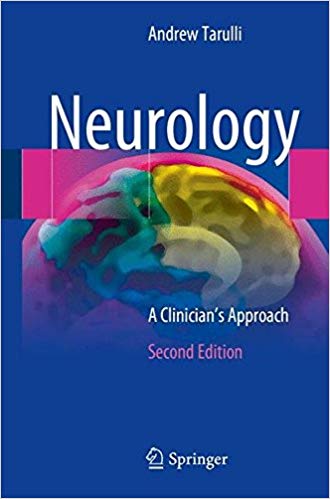There are many different ways to organize a neurology textbook. A book might be organized anatomically (for example, brainstem disorders or peripheral neuropathies) or on the basis of specific diseases (for example demyelinating diseases or tumors). The problem with these ways of organizing neurology is that patients who are in need of a diagnosis don’t come with a label. Rather, they present with a symptom or chief complaint, and it is the task of the clinician to come up with a diagnosis.
The idea behind Neurology: A Clinician’s Approach (2016), therefore, is to group diseases in the way in which they appear clinically. So strokes (Chapter 21), for example, are discussed along with various stroke mimics such as focal neuropathies, Todd’s paralysis, metabolic insults, and so forth. Similarly, seizures (Chapter 20) are discussed in the context of syncope, migraines, and movement disorders.

This way of categorizing things is imperfect, though. There are some diseases that are very difficult to classify on a basis of a specific presentation or chief complaint. For example, multiple sclerosis has a highly variable presentation and natural history. So it would make little sense to discuss this condition in virtually every chapter of the book (for example, under Diplopia, Focal Limb Weakness, Distal and Generalized Sensory Symptoms, etc.). So instead, multiple sclerosis gets its own chapter where clinical presentations are discussed along with the clinical courses that are most consistent with this condition.
The previous edition of this book (2010) was excellent. It was printed on better and larger paper, the book was concise and manageable and the cover was dynamite. Just look at how neurology-ish it is!

In contrast, the current edition has a blasé cover (see first picture above). More importantly, the pages are smaller and of poorer quality. The book is, as a consequence, chubbier, more unwieldy, and less readable. It is 450 pages long instead of the prior edition’s 240 pages. (It’s almost as if the second edition is trying to make itself into a textbook when it was doing just fine all along without being one!)
As one Amazon reviewer put it:
Bit disappointed with this edition as not much change from the 1st edition. The new publisher has poor and boring layout of information and i still hold on to the first edition as it is reader-friendly and the layout is so much more attractive. nothing new or striking this edition but a poorer layout.
“Amazon Customer”
I didn’t compare both editions with one another line by line so I can’t say that I agree with the reviewer above on every point. However, I can say that the previous edition was much more readable and that’s the one I’d buy to start with. That is the edition that I own and the one I intend to keep. Also, the current edition sells for more than $100 US, while the older version sells brand new for approximately $18! So I would definitely buy the earlier edition first!
So who should read this book? One neurologist’s view is quite instructive:
I had the privilege of being the chief resident on the stroke service … and when my junior residents arrived, they asked me which books they ought to buy. I gave them a long list, but I made sure to explain why [Neurology: A Clinician’s Approach] should be the first to read. I think that is true for any medical student … neurology resident … and internist.
Marc Albert Bouffard, M.D. (from 2016 Forward)
I agree with most of Dr. Bouffard’s assessment. However, my view is that Neurology: A Clinician’s Approach is probably a bit too advanced for the average medical student, and I would therefore not recommend it as a first book for most medical students. Rather, I recommend it to more advanced rotating third and fourth year medical students, particularly those with a serious interest in internal medicine, neurology or neurosurgery.
Once again, the first edition got this one right in this regard: “The book is written for advanced medical students and residents early in training and is a practical guide to patient care…. ~ Michael Ronthal, MB Bch (from 2010 forward emphasis supplied).


Leave a Reply